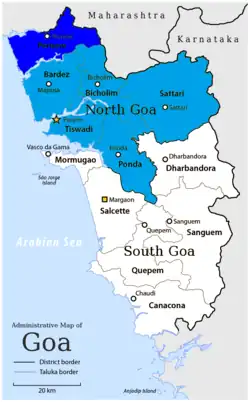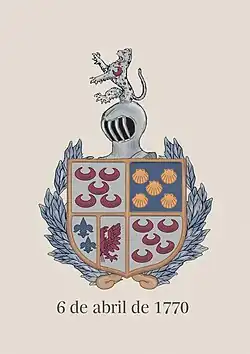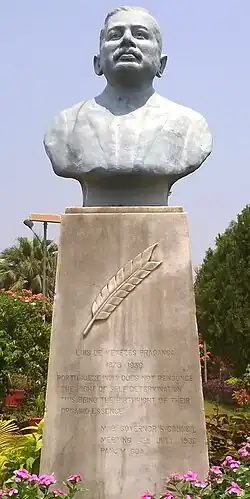List of peers and fidalgos in Portuguese India
_-_Autor_desconhecido.png)
The Kingdom of Portugal gave titles and created coats of arms for notable persons in Portuguese Goa, including native Goans. However, these titles lost their recognition after the 5 October 1910 revolution and start of the First Portuguese Republic in 1910.
Peerages

Peers
- Duke of Goa. This hereditary title was given to Afonso de Albuquerque by Manuel I of Portugal following the Portuguese conquest of Goa.
- Marquis of Alorna and Count of Coculim.[1] These hereditary titles are currently held by the present Marquis of Fronteira.[2] Their realm included the villages of Morjim and Mandrem amongst others.
- Count of Nova Goa. This hereditary title was originally bestowed on Luis Caetano de Castro e Almeida Pimentel de Sequeira e Abreu (1840—1914) of Panjim in 1864 by Luis I of Portugal. The current holder of the title is his descendant Luis Eduardo de Mendia de Castro (1943—).
- Count of Mahem. This is a hereditary title given to the Noronha family of Mayem in Bicholim.[3]
- Baron of Cumbarjua. This title was given to Tomás Morão from Cumbarjua. While the family is extant, the title is considered as extinct as it was given for his life and was not renewed.
- Baron and Viscount of Perném. The title of Baron was given to the ruler of Pernem, Vassudeva Deshprabhu, by decree of 14/6 /1878 (Luís I of Portugal). His son Atmaram Vassudeva Deshprabhu, Commander of the Order of Christ (1891), was elevated to Viscount by decree of 19/8/1893 (Carlos I of Portugal). There is succession from the first Viscount to the present day. MLA Jitendra Deshprabhu and Pernem Municipal Council member and politician Vasudeva Deshprabhu are direct descendants. Jitendra Deshprabhu had the title re-affirmed by Duarte Pio, Duke of Braganza heir to the throne of Portugal in the 21st Century. While this was also given to Viscount Deshprabhu in his life (comparable to the British Life peer as the Portuguese royal family made few hereditary peerages) his heir Jitendra had it renewed by Duarte Pio, Duke of Braganza in the 21st century.
- Baron Dempo. Created in 1873 for Krishna Govinda Rayú Sinai Dempo, 1st Baron Dempo, a wealthy zamindar and trader.[4] His descendant Vaikuntrao Dempo was the last member of parliament in Portugal prior to the independence of Portuguese India. His brother Vasantrao S. Dempo was the founder of Dempo Mining Corporation and owner of football club Dempo S.C.. While the family is extant, the title is considered as extinct because it was given for his lifetime and was not renewed. The Dempo family continues to be involved in politics and business, and is considered Goa's wealthiest family.[5] The Dempo family was among the 10 richest in India post independence.[6]
- Baron Kenkre of Calapor. given to a wealthy capitalist and trader named Purshottam Sinai Kenkre, Hindu zamindar, residing in Diu, Knight of the Order of the Tower and Sword, by decree of 3/2/1853. Decree of 26/6/1873 Luis I, in his life. While the family is extant, the title is considered as extinct because it was given for his lifetime and was not renewed.
Extinct
- Viscount of Bardez. Inácio Caetano de Carvalho, lawyer and journalist, was born in Camurlim, Bardez, on 9/5/1843 and died on 9/15/1907, of an ancient Brahmin family from Salcette. At the beginning of the 19th century, when a plague broke out, the Carvalho family settled in the beginning of the 19th century in the village of Camurlim. He was the son of Joaquim Salvador de Carvalho, one of the most eminent jurists of his time. He obtained a lawyer's license at just 20 years old, occupying various positions in the local administration and in Diu. As a journalist, he was editor-in-chief of the newspaper O Mensageiro and later of O Oriente, a newspaper that later merged into Gazeta de Bardez. In 1877 he founded A Pátria, which for many years occupied a distinguished place in the local press. As a politician, he was head of a large party that, for many years, dominated the councils of Bardez, affiliated to the “dynastic-left” association, founded in Portugal by José Vicente de Freitas; and then in the Regenerator Party, then under the leadership of António de Serpa Pimentel. On 8/19/1893 he was awarded the title of Viscount of Bardez.
Fidalgos

The fidalgo is a Portuguese noble distinction granted to certain Goans who were lawyers, merchants and diplomats. These Christians were considered to be included in the Portuguese nobility. The fidalgos detailed here are only those whose distinction was hereditary. This distinction ranks above baronet as they form part of the nobility similar to the Spanish Hidalgo (nobility) while the baronet is a commoner despite it being a hereditary title. However fidalgo ranks below Baron.
Extant
- Alvares of Margao. Created in the first half of the 1700s for Vincent Alvares, a medical practitioner and chemist of John V of Portugal. His descendant José Filipe Alvares assisted Swami Vivekananda in studying Christianity during the latter's visit to Goa.These arms and position of nobility could be bequeathed to their heirs.
- Pinto of Candolim. Created in 1770 for António and Ignacio Pinto. The Pintos descended from the Brahmin Salvador Pinto alias Santu Sinay, a historic figure in the village of Candolim. They were a military family who initially supported the Portuguese government before participating in the Conspiracy of the Pintos. The Pinto family were defeated in their plans but went on to assist in the French Revolution and fight for the Maratha Empire before returning to Goa. The house of the Pintos today stands as Bosio Hospital in Candolim which was donated to he Sisters of Charity of Sts. Bartolomea Capitanio and Vincenza Gerosa by heirs of Ignacio Pinto in Pinto Vaddo. These arms and position of nobility could be bequeathed to their heirs.
- Monteiro of Candolim. Created in 1802 for José João Monteiro, a military officer from Candolim. His descendants are Dr. Gustavo Monteiro, the benefactor of Dr. Gustavo Monteiro Football Ground of Candolim and Chico Monteiro, a freedom fighter.

- Bragança of Chandor. Created in 1877 for Francisco Xavier de Bragança of Chandor. His heir Luís de Menezes Bragança was a prominent journalist, writer, politician and anti-colonial activist. During his lifetime, Menezes Bragança was widely hailed around the Lusosphere (Portuguese speaking world) as "O Maior de todos" ("The Greatest of all Goans") and in the Indian mainland as "The Tilak of Goa". At his 25th death anniversary in 1963, the Instituto Vasco da Gama was renamed by its management to Institute Menezes Braganza in honour of his memory. These arms and position of nobility could be bequeathed to their heirs.

- Miranda of Loutolim. Created in 1872 for Constâncio do Rosário de Miranda of Loutolim. After serving as a soldier in the Portuguese Army, his father Pedro Joaquim de Miranda was the Fiscal Administrator of the Novas Conquistas. One of his descendants was the cartoonist Mario Miranda. These arms and position of nobility could be bequeathed to their heirs.

References
- ^ Times, Navhind (January 13, 2023). "The land grab of a militant people | The Navhind Times | Goa News".
- ^ "Re: [Goanet]FEATURE: Killer cocktail of prescription drugs, narcotics haunts Goa coastline".
- ^ "Colonialism's Shadow Lingers over Goa Village". www.daijiworld.com.
- ^ Technologies, Sancoale (October 14, 2000). "Kalpavriksha Family".
- ^ "Srinivas Dempo only Goan to feature in India's rich list". The Goan EveryDay.
- ^ "New breed of millionaires in Goa in the offing". India Today. March 11, 2014.